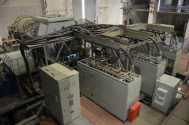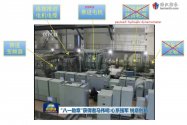broadsword
Brigadier
The GE LM2500 weighs 5.25 tons. If an industrial gas turbine weighs 15 tons, I think the difference of 10 tons is probably not an issue for a navy ship as small as a frigate. It is not 100 tons.


There are big differences however. UK Type 45 uses a AC power distribution and so does Zumwalt class, where as the Chinese are using medium voltage DC power distribution. This is a huge difference, and will likely contribute to quite different reliability characteristics. For a quick overview of DC vs AC power distribution system on boat, seeWorth to note is that UK use coverteam 20MW drive for their IEPS, USN Zumwalt class use the same 20MW (perhaps uprated) module as well.
There are big differences however. UK Type 45 uses a AC power distribution and so does Zumwalt class, where as the Chinese are using medium voltage DC power distribution. This is a huge difference, and will likely contribute to quite different reliability characteristics. For a quick overview of DC vs AC power distribution system on boat, see
Most IEPS motor are DC motor. I am not sure if UK Type 45 and Zumwalt do a AC-to-DC conversion before feeding into the IEPS motor. It is interesting to note that both Type 45 and Zumwalt have been beset by electrical system/propulsion reliability issues; but it is not clear whether that had to do with the additional complexities presented by an AC distribution power system.
Benefits of DC-grid
Benefits of the DC-grid system in ships could be explained in two aspects. One is the power stability and quality aspect, and the other is the economic and environmental aspect as below.
Power stability and quality benefits
In the AC-grid system, both voltage and frequency are required to be monitored and controlled for maintaining the power stability. However, in the DC-grid system, there are no reactive power interactions, and then the system control is oriented to the voltage only. Therefore, the DC-grid has advantages of keeping the power stability than that of the AC-grid.
In addition, the synchronization of generators is simpler than the AC-grid. In the AC-grid system, it is necessary to consider the voltage, frequency, phase angle during synchronizing more than two generators. However, in the DC-grid system, only the voltage is a crucial factor.
In the view of the power quality in the AC-grid, the main troublesome is the harmonic distortion (Jayasinghe et al. 2017, 1–12). Especially, electric propulsion ships with many variable frequency drives (VFDs) have suffered from the harmonic distortion issue. In a VFD, a rectifier converts a constant voltage from an AC, and an inverter recreates the AC at the required speed for the road; this might arise the harmonic distortion issues (Bossert, et al. 2017, 487). To solve this problem, the harmonic filters had been installed additionally in the past, and then, the phase-shifting transformer has been commonly installed in front of the VFD for generating 12 or 24 pulses. Even though the advanced VFD such as an active front end converter could reduce the harmonics significantly, its price is rather higher than others.
However, in the DC-grid system, it is unnecessary to transfer an AC to a constant voltage (DC), and thereby the rectifier part in the VFD could be eliminated. Thereby, power losses and harmonic distortions into the connecting load could be reduced. Consequently, the DC-grid is well suitable for ships with many VFDs to control motors such as heavy-lifting cranes, propulsion or thruster motors, pumps, compressors, etc. (Geertsma et al. 2017, 47).
To summarize, the DC-grid system has following benefits compared to the AC-grid in terms of the power stability and quality aspect.
- Freedom of the reactive power (increasing power stability)
- Freedom of the frequency (easy synchronizing of power sources)
- DC-based power distribution (reducing harmonic distortions and increasing power quality)
Economic and environmental benefits
In the AC-grid system, a genset (generator and prime-mover) has to run at the given fixed frequency of 50 or 60 Hz. However, the specific fuel oil consumption (SFOC) of a genset is different depending on its load, and it is designed to optimize around 75–85% load factor typically (ABB 2017a). When operating at low load, the SFOC becomes higher as shown in Figure 1. However, in the DC-grid system, gensets can operate with variable frequencies, so it has a wider operating window with high fuel efficiency. It is known that the DC-grid system could reduce the fuel consumption and emissions by up to around 20% depending on the ship type
As mentioned above, most electric propulsion ships have been equipped with additional equipment to mitigate harmonic distortions such as harmonic filters or phase-shifting transformers, whereas these are no longer necessary for the DC-grid. Also, the rectifier part (AC/DC) in the VFD can be removed. Thereby, it can make more cargo spaces on a ship.
In addition, it is effortless to integrate DC power sources (e.g., fuel cells, lithium–ion batteries, supercapacitors, etc.) into a DC-bus. Especially, the ESS could be used for various purposes: peak shaving, load leveling, absorbing regenerative power, etc. Therefore, the ESS can reduce gensets’ running time and improve energy efficiency. Besides, it can also contribute to reducing the maintenance cost of gensets.
Lastly, large ships with several MW-class generators may encounter a problem with power supply when harboring at a port. Sometimes, a smaller additional generator has to be installed only for power supply at the port. On the contrary, an additional generator for harbor use is not necessary anymore in the DC-grid system, because the variable speed generator has low fuel consumption even when operating at low load such as harbor operations (Kokkila 2012).
- To summarize, the DC-grid system has following benefits compared to the AC-grid in terms of the economic and environmental aspects.
- Variable speed/frequency operation of gensets (reducing fuel consumptions, emissions)
- Removing a rectifier in a VFD for motor controls (reducing weight and volume)
- Eliminating harmonic mitigation equipment (reducing weight and volume)
- Easy integration of DC power sources to a DC-bus (improving energy efficiency)
- Unnecessary for an additional small generator for power supply at a harbor in case of MW-class large ships (saving the cost of a small genset)
I know that, I was emphasizing the power output being in the same class for the similar application "destroyer around 10000 ton displacement with two drive shaft." In other words, I was trying to say that this test rig is meant for type 055 class.There are big differences however. UK Type 45 uses a AC power distribution and so does Zumwalt class, where as the Chinese are using medium voltage DC power distribution. This is a huge difference, and will likely contribute to quite different reliability characteristics. For a quick overview of DC vs AC power distribution system on boat, see
Most IEPS motor are DC motor. I am not sure if UK Type 45 and Zumwalt do a AC-to-DC conversion before feeding into the IEPS motor. It is interesting to note that both Type 45 and Zumwalt have been beset by electrical system/propulsion reliability issues; but it is not clear whether that had to do with the additional complexities presented by an AC distribution power system.
I stand corrected. Did a bit more digging. Type 45 is a VFI driven induction motor. As you said, variable frequency.No, most (if not all) IEPS use AC motor including the Chinese ones. To change RPM one need to change the frequency. A DC grid will convert the DC to AC first, then using power semiconductors to change frequency, then drive the AC motor. In the article, it says "advanced fifteen-phase propulsion induction motors". Induction motor is AC motor.
The difference between the US/UK system and Chinese system is the power bus being AC vs. DC. The motors are all AC induction motor.
The benefits of DC are with grid management and design, not with the power train itself.I stand corrected. Did a bit more digging. Type 45 is a VFI driven induction motor. As you said, variable frequency.
Even though the IEPS uses an AC motor, the motor frequency is decoupled from the AC distribution frequency. As such from the perspective of driving the IEPS motor there is no simplification benefits to use AC power distribution vs DC. Either way there needs to be a power driver to generate the variable frequency AC.
